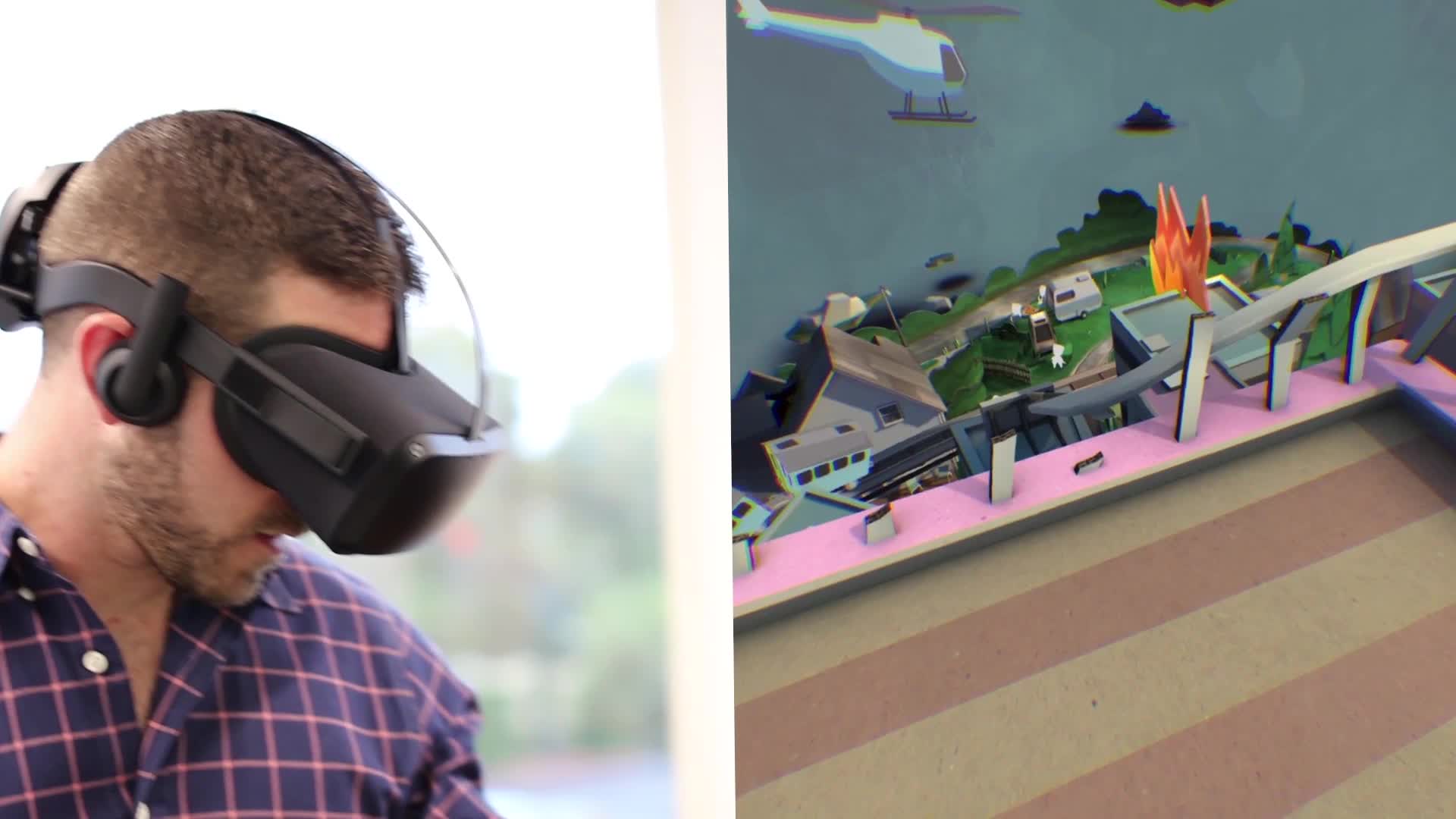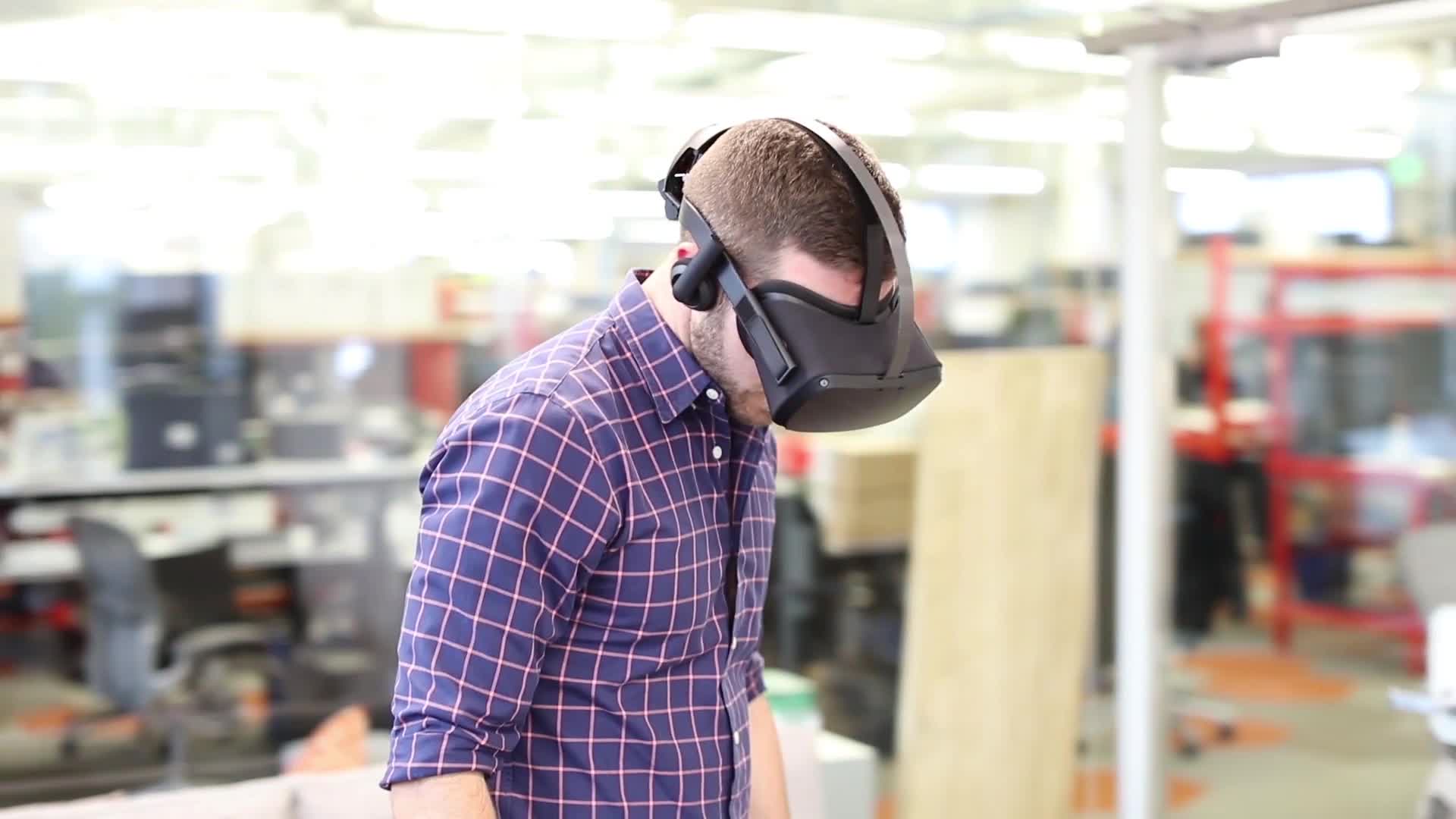Oculus Rift, Untethered: Project Santa Cruz, Hands On
The VR HMD panacea is a completely untethered experience, free of both wires and a companion PC. Oculus is making one: Called Project Santa Cruz, it’s a version of the Rift that has its own computer on board, and we got a chance to experience it firsthand at Oculus Connect 3.
What It Is
To be clear, this is not simply a wireless version of the Rift; that is, they did not replace the cable with a wireless solution. Instead, Project Santa Cruz is a self-contained VR HMD with its own computer on board. Therefore, it’s “wireless” in the same way that Microsoft’s HoloLens is wireless, in the same way that a smartphone is wireless.
The whole system is inherently mobile, and it offers six degrees of freedom (6DoF), which is a huge deal. The Gear VR, for as great as it is, offers only 3DoF. The 6DoF capability is so crucial because it adds spatial tracking, so you can physically walk around, and the virtual environment will respond accordingly.
Oculus would not allow us to take pictures or video, and the demonstrators would not divulge much in the way of specifics. However, based on our direct observations, experience using the headset, and inferring some details based on our conversations, we have a picture of what Project Santa Cruz is and how it’s built.
First of all, it is an Oculus Rift; it’s just been added onto. There is a computer on board, attached to the rear headstrap. We say “computer,” not “PC,” because Oculus would not divulge what, exactly, the computer entailed. However, we’re reasonably certain that this is essentially mobile hardware.
Although we could not see the CPU socket, we could see some of the PCB as well as its general size. It’s just a few inches square (rectangled, actually)--too small to be socketed, and there’s no room for discrete RAM, for example. Further, the person in charge of the project runs mobile for Oculus, so it makes sense that he would be more likely to employ a high-end mobile SoC (such as that found inside the Samsung Galaxy phones that power the Gear VR) over a “mobile” PC chip like Intel Cherry Trail. Then there are John Carmack's comments (further down the page). Whatever it is, it’s covered by a copper heatsink and employs a fan.
We therefore believe that the operating system--and there is an operating system--is probably Android, or a version of it.
Get Tom's Hardware's best news and in-depth reviews, straight to your inbox.
The (probably custom) PCB also has three USB ports (at least two of which are USB 3.0) and an HDMI port. Velcroed under the makeshift computer is a battery pack. It looked like it was probably a Li-ion rechargeable battery pack.
Note that Oculus representatives repeatedly said that this was a prototype and the final design and its actual components, including the cooling elements, are very much a work in progress. The company takes prototyping and testing on live subjects (read: us) pretty seriously.
There are no external trackers involved with Project Santa Cruz, no Constellation cameras. Instead, Oculus employed inside-out tracking. It added four cameras, one on each corner of the front of the HMD. These are not special IR cams or anything--they’re just the sort of cameras you’d find in a smartphone. We do not know the resolution. So how does this Rift perform tracking? The biggest clue is that the two fellows running the demo are computer vision guys. The cameras provide a certain amount of data, and then that data is piped via HDMI to the SoC. And there are the typical IMUs inside most smartphones and HMDs. The software performs sensor fusion, based only on the data from the cameras.
What It’s Like
It didn’t occur to me until after the demo, but I noticed almost no issue with the added weight of the computer and battery pack.
It’s hard to describe how bizarre it felt to be using a Rift with no wires. It felt almost too free, which was actually a little disorienting. There were two issues I discovered:
First, although I could move about freely in the virtual world, my hands, arms, and legs were not present, which threw me way off. This is a common issue in many VR experiences; it’s disconcerting to your brain when your body moves but you have no corresponding visual cues.
Second, it occurred to me that although we’ve all been waiting eagerly for the day when we could get rid of that pesky cable running down our backs, it actually provides you important tactile feedback that helps your brain orient your body within a physical space, even as your visual system is immersed in a virtual one. (This is not to say that I pine for the cable’s return--simply that without the cable and without any sort of body tracking, the untethered 6DoF experience is bizarre.)
The demo took me into two virtual spaces. One was a mostly empty area that felt like the launch bay of a spaceship. Nothing happened in there, other than I was able to walk around a little and test the boundaries of the Guardian system. (Yes, this untethered Rift already has the Guardian system.)
Within a couple of minutes, I was transported to a cartoonish scene. I was standing in a yard, with shrubs and flowers around me. Just beyond the grass was a street, and beyond that was a cliff and the ocean. I was able to walk around my small yard, but I couldn't interact with anything.
Suddenly, a UFO descended. I looked up to see the tractor beam glowing down at me.
The scene faded to and from black, and the UFO dropped me on a rooftop patio above the yard. I could step close to the edge of the roof (my brain screaming “Danger!” the whole time), but the Guardian system popped up to prevent me from toppling over the side/bumping into a physical couch.
The UFO lit me up again, and the demo ended.
I found that even though I knew the Guardian system would tell me when I was near a wall or object, I moved slowly, with small steps and trepidation. That would all be ameliorated if the system was not just performing object tracking, but showing it to me, and if that same detection system gave me a facsimile of my limbs, or at least my hands.
It's not clear if that will be possible with Project Santa Cruz. On one hand, using that camera data should make object- and hand-tracking simple. On the other hand, the software would have to stitch the images from four cameras in real-time, which sounds like an awful lot of computation for a system that already has much to do. But, then again, Oculus could do what Intel is doing with Project Alloy and Realsense, which is to remove the sensor data processing from the SoC entirely. However, because Project Santa Cruz appears to be fundamentally using software sensor fusion, that may not work.
What It’s Not
Whatever Project Santa Cruz is, it’s not just a muscled-up version of the Gear VR. Remember, Gear VR is sort of a “dumb” device that relies on a smartphone for its display and processing. Project Santa Cruz is a complete system that is also fundamentally an Oculus Rift. Further, the Gear VR offers just 3DoF, whereas this new prototype has 6DoF.
It’s also not being used in the same way the Rift is normally used. The Oculus Rift and HTC Vive are not systems; they're essentially mega-peripherals that rely on powerful PCs and external sensors. Project Santa Cruz does its own sensor work and is totally portable. Forget roomscale; Project Santa Cruz is a world-scale VR HMD.
What It Means
“Inside-out tracking” is a downright buzzword right now. We heard it all over OC3, and elsewhere. What is happening is that the XR world is evolving, and quickly. As users began to pine for the ability to move more within VR, we needed roomscale tracking. Now we have it. We needed tracked hand controllers. Now we have it. To have a safety system as we shuffled around in VR, we needed Guardian. Now we have it.
The next need is untethering our HMDs while maintaining 6DoF--in whatever form that takes--but that requires solving a host of problems. However, inside-out tracking is one of those problems, and Oculus is on its way to solving it. There was no discussion of how controllers fit into this mix, but at least in terms of being tracked. That's another problem for another day.
What Carmack Says
On stage at the closing keynote of OC3, John Carmack expounded a bit more on Project Santa Cruz.
He seemed to confirm what we suspected--that it runs on fundamentally mobile hardware--but he discussed how Project Santa Cruz can get more from a mobile SoC than a phone can. For example, phones are phones first. Many are provided by carriers, they have baseband processing that hogs resources, they have bloatware (some of it from carriers), they have much happening in the background like Wi-Fi and GPS, and all of these things consume power and many of them cause thermal problems when you’re trying to render video, and so on. VR engineers, he said, can make use of only about one third of the total power resources of the SoC on a phone.
However, with the mobile SoC and DSP extracted completely from a phone use case, all that power is freed up and can be dedicated to the VR experience. You can also--as we saw--cool the chips with a heatsink and fan, or eventually other, smaller mechanisms. In other words, a decidedly mobile processing pipeline just for VR. In other words, something akin to a gaming console, and in fact Carmack made that comparison, extolling the performance virtues of having a single, immovable, predictable target for developers.
Carmack is envisioning a VR future where a billion people can enjoy great VR, and in order to offer that, the devices need to be mobile and get cheaper. The Rift, of course, is tethered and expensive, so you can see where Oculus is headed with Project Santa Cruz. And it would seem that Samsung and its Gear VR compatibility eventually will be a much different part of the Oculus vision.
Seth Colaner previously served as News Director at Tom's Hardware. He covered technology news, focusing on keyboards, virtual reality, and wearables.
-
bit_user They should add a couple depth cameras, in order to bring your body into the virtual world.Reply
Forget roomscale; Project Santa Cruz is a world-scale VR HMD.
Is it? Do we know that it works outdoors? Do we know that it works in large spaces? Does it have loop closure?
Google's Project Tango (and presumably MS' Hololens) has been working on this problem for several years. There are some important nuances, once you go beyond (small) room-scale.
-
Kimonajane Is Tom's Hardware on the Facebook payroll? Look at the latest articles 50%+ are Oculas or Facebook related stories. Well ex_bubblehead, are you guys getting kick backs to promote Facebook, a pawn for the FED?Reply
He will probably ban me again now, speech police don't you know. -
dark_lord69 Reply18701022 said:Is Tom's Hardware on the Facebook payroll? Look at the latest articles 50%+ are Oculas or Facebook related stories. Well ex_bubblehead, are you guys getting kick backs to promote Facebook, a pawn for the FED?
He will probably ban me again now, speech police don't you know.
Don't be ignorant.
Facebook owns Oculus...
Oculus makes virtual reality hardware and software...
Virtual Reality is new consumer technology...
Toms reports on new technology (not just 100% computer tech).
Even if they did only report on computers and computer parts this would STILL be related because of the powerful system needed to use the Oculus or HTC Vive. Plus this article points out that their new prototype is a powerful SoC, which is not only new tech it's also a "System on a Chip" (SoC) engineered for a unique purpose. -
bit_user Reply
Hey, you noticed an interesting pattern. Maybe there is something to that! But not all patterns reveal hidden conspiracies.18701022 said:Is Tom's Hardware on the Facebook payroll? Look at the latest articles 50%+ are Oculas or Facebook related stories. Well ex_bubblehead, are you guys getting kick backs to promote Facebook, a pawn for the FED?
He will probably ban me again now, speech police don't you know.
So, I think this probably started the recent burst of Oculus news articles:
http://www.tomshardware.com/news/oculus-connect-3-event-schedule,32807.html
When there's a developer conference, you get a lot of announcements from both the lead party (Facebook/Oculus) and their partners. Tom's is writing separate articles about these announcements pretty much as they come out (maybe they fell behind and had a little catch-up to do). In a bigger conference, like E3 or CES, there are so many announcements that a lot of stuff just gets grouped together into a "Best of show" article.
Not everything is a government conspiracy. And being paranoid doesn't mean they're not after you.
-
wifiburger seriously ! Carmack he must of been payed,Reply
gps, wifi, background apps consume mobile soc resources ? seriously no ! I have those running in background and makes no difference for games even for low end phones,
that thing looks like garbage, high end phones have better vr ! -
nubro01 Sound a lot like a Sulon Q like solution, what about that Sulon Q, hd an announcement and then it went quiet.Reply -
nubro01 Sound a lot like a Sulon Q solution, what about that Sulon Q, had an announcement and then it went quiet. What's happening at Sulon.com ?Reply -
bit_user Reply
Yeah, that was some serious spin. I thought he was above such things.18705156 said:seriously ! Carmack he must of been payed,
gps, wifi, background apps consume mobile soc resources ? seriously no ! I have those running in background and makes no difference for games even for low end phones,
Now, I can see the point about how they can cool it much better than a phone - particularly one that's partially enclosed inside a visor. Also, I would hope for a big battery you could wear on your back or your belt. That would also help them clock it higher than a phone.
-
bit_user Replytherealduckofdeath voted down for this answer 2 minutes ago
Alright, if such background services do have a significant performance penalty, then why don't they kill your battery like 1/3rd as much as a game?
They don't have that degree of battery drain, because they have almost no performance impact. You can't have significant performance impact without roughly proportionate battery drain. -
Jeff Fx >The VR HMD panacea is a completely untethered experience, free of both wires and a companion PC.Reply
Getting rid of wires would be a big deal. Getting rid of a powerful rendering system, and going back to phone-quality VR, would not be progress. A big hot box with a bunch of fans blowing is always going to be able to do a lot more work than a device that mounts to your head.


